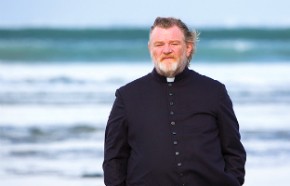Priest under threat

Father James Lavelle (Brendan Gleeson) is a faithful, genial priest living in what initially looks like an idyllic corner of western Ireland.
In the confessional, he hears a man report being savagely abused by a priest throughout his childhood. As revenge, the man has determined to kill Father James, not because of any suspicion that he is a molester himself but solely because he is a priest. He will carry out his threat on a Sunday in two weeks’ time. Father James knows the identity of his potential murderer, but the audience does not—nor will he share the name with any of his neighbors.
Thus begins Calvary, an extraordinarily fine Irish film, beautifully acted by some of that country’s finest performers, and visually stunning. It is a masterpiece of religious filmmaking, exploring such critical concepts as collective sin, vicarious guilt, and sacrificial death. The film offers a wide-ranging study of the catastrophic effects of religious scandal on believers.




